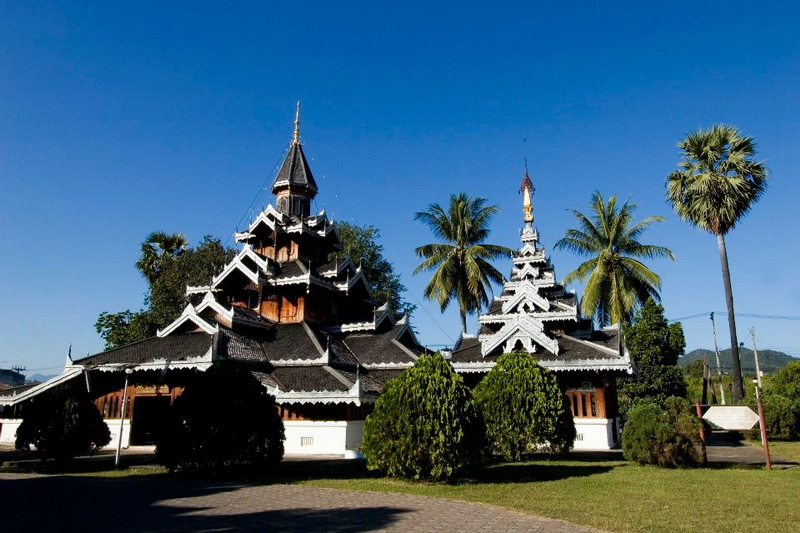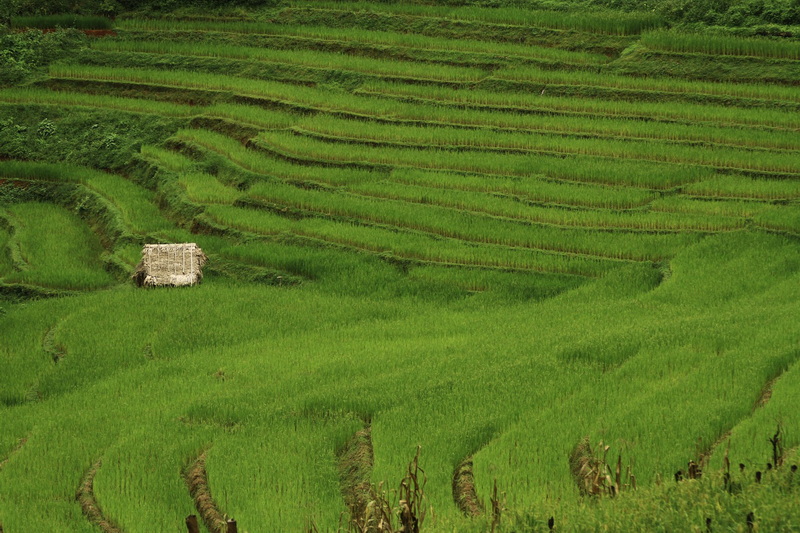Wat Chong Klam and Wat Chong Klang are the most famous landmarks of Mae Hong Son City

Wat Chong Kham & Wat Chong Klang: The Cultural Twin Temples of Mae Hong Son
Nestled beside the tranquil waters of Nong Chong Kham Lake, Wat Chong Kham and Wat Chong Klang stand as timeless spiritual beacons and cultural symbols of Mae Hong Son. These two temples—though historically distinct—are located within the same temple compound and have long been regarded as twin landmarks that reflect both the religious devotion and rich heritage of the local Tai Yai (Shan) community.
Historical & Cultural Legacy
Wat Chong Kham, founded in 1827 by Phaya Singhanatracha, is recognized as the first Buddhist temple in Mae Hong Son. Originally called “Wat Sai Yok,” it earned its current name from the gold leaf-covered columns in its viharn (ordination hall). Not far from it, Wat Chong Klang began as a sermon hall under Wat Chong Mai but was later established as an independent temple in 1867 when Burmese monks from Mawkmai settled in the area.
Due to their physical proximity and shared spiritual role, both temples were officially merged into one compound in 1974 and were granted the status of a third-class royal temple in 1984. Despite their administrative unity, each temple retains its own distinct identity, story, and architectural charm.


Architecture & Artistic Significance
Both temples beautifully reflect Shan (Tai Yai) Buddhist architecture, infused with Burmese influence.
- Wat Chong Kham is known for its striking nine-tiered viharn roof, designed in the Shan royal palace style—symbolizing a sacred space reserved for kings and the divine. Its architecture blends local and Western elements, seen in the arched windows and delicately carved wooden fretwork, often referred to as “gingerbread-style.”
- Wat Chong Klang, meanwhile, features a unique “chong” hall with multi-tiered zinc roofs and a stunning Mon-style chedi topped with a three-tiered umbrella (chatra), showcasing intricate craftsmanship and religious symbolism.
Sacred Artifacts & Living Heritage
Each temple houses rare religious treasures that are as spiritually powerful as they are culturally valuable.
- At Wat Chong Kham, you’ll find Luang Phor To, the province’s largest Buddha image, created by Burmese artisans in 1926 as a replica of the Buddha at Wat Suthat in Bangkok.
- Wat Chong Klang, on the other hand, is often called a “living museum.” Its interior hosts the Wat Chong Klang Museum, a stunning collection that includes:
- 33 intricately carved wooden dolls from Burma, depicting scenes from the Vessantara Jataka.
- Glass panel paintings from Mandalay, telling stories from Buddhist scriptures, with Burmese inscriptions.
- Ancient Tai Yai manuscripts, Chinese porcelain, marble Buddha statues, and ceremonial items from centuries past.

Wat Chong Kham


Spiritual Heart of the Community
Beyond their physical beauty, these twin temples serve as the emotional and spiritual core of the Mae Hong Son community.
- In the early morning and evening, the area around Nong Chong Kham Lake becomes a peaceful sanctuary, with temple reflections shimmering across the water—especially magical at sunset when the structures glow under soft lighting.
- By nightfall during the cool season, the area transforms into the Mae Hong Son Walking Street, where food vendors, craft stalls, and cultural performances bring vibrancy to the temple’s surroundings, turning it into a dynamic social hub.
- For the locals, these temples are not just places of worship but sacred venues where age-old customs are preserved—such as the Phra Upagupta rite, believed to ward off bad luck before major festivals.
Festivals & Cultural Events
The temples play a central role in Mae Hong Son’s annual religious calendar, particularly among the Tai Yai population.
- The grand “Ock Hwa” Festival, marking the end of Buddhist Lent, sees the community crafting elaborate miniature castles known as “Chong,” which are paraded and offered to monks in a vibrant procession.
- Throughout the year, the temples continue to host alms-giving ceremonies, merit-making events, and traditional Buddhist rituals, keeping Mae Hong Son’s spiritual rhythm alive.

Wat Chong Klang


Why You Should Visit
Visiting Chong Kham and Chong Klang Temple is more than just a sightseeing stop—it’s a journey into the cultural soul of Northern Thailand. Whether you are drawn by the majestic Buddha statues, fascinated by rare religious art, or simply enchanted by the lakeside serenity and vibrant community life, these twin temples offer a deeply moving and enriching experience for every traveler.


Opening Time : The temple opens daily during daylight hours 6:00 – 18:00
Address : Wat Chong Kham and Wat Chong Klang, T.Chong Kham, Mueang Mae Hong Son District, Mae Hong Son 58000, Thailand
GPS Coordinates Map : 19.297907, 97.968002
Entrance : Admission to the temple is free but donations are suggested.
How to get there :
Wat Chong Kham and Wat Chong Klang are located in the center of Mae Hong Son City.Near the area of Nong Chong Kham Lake.
- By public vehicles :Tourists can rent a Tuk-Tuk , or Son Taew (Two-row seated bus) from the town up to Wat Chong Kham and Wat Chong Klang
- By personal vehicles
- Tour company or travel agencies can arrange transport via air-conditioned car, van or mini-bus.
- By renting the bicycle or Motorbike.
Note : Wheelchair user is accessible
Nearby Places
Wat Phra Non has a unique of its own. A gigantic Buddha statue of the lying-down manner is located there. In case you’re confused, the word ‘phra’ here means ‘Buddha statue’ and the word ‘non’ means ‘lie down’. Now, that makes sense why the temple was named as Wat Phra Non.
The temple ‘Wat Hua Wiang’ is also known as ‘Wat Klang Wiang’. It was built in the year 1863. You may wonder why the temple is called like that. Well, the true reason started long time ago. It is belived that the temple was built on the head of Mae Hong Son downtown.









Leave A Comment